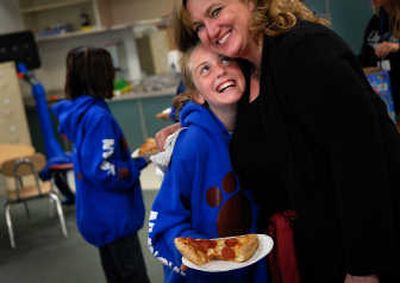Peer-teaching conflict resolution

Instead of allowing a disagreement to escalate or waiting for a grown-up to intervene, students at Moran Prairie Elementary have discovered a new way to solve conflicts at school.
They turn to their peers.
By filling out a green card, also known as a “request for mediation,” students at this South Hill school seek help from other kids who have been trained to resolve conflict.
Known as Peer Leaders, these fifth- and sixth-graders not only guide their fellow students through problem-solving; they also promote alternatives to violence by encouraging kids to calm down when they’re angry, understand each other’s perspectives, brainstorm for solutions and to reach out and “talk peace.” The program was honored last month with the Chase Youth Leadership Award.
“They help students view conflict as an opportunity for communication as opposed to something that should be avoided or allowed to escalate,” explained Jacquie Johansson, the school counselor who introduced the formal mediation process to Moran Prairie students four years ago.
At a time when bullying and harassment seem to have become more prevalent among kids as young as first or second grade, educators such as Johansson want to make sure that students are learning how to listen to each other and work together in order to solve problems and promote understanding.
So instead of getting into a yelling match or even a fist fight, students are learning and teaching each other skills that enhance self-esteem and emotional intelligence while creating a safe atmosphere for kids.
“Emotional intelligence is equally important as math, science and other subjects,” said Johansson, a Spokane Public Schools counselor for the past 16 years. “These are skills they will use in the world. … It’s important for them to learn how to deal with conflict and to do it in a respectful manner. These are stepping stones to tougher decisions that they will face as adults.”
Leadership programs exist at many area elementary schools, but the Peer Leaders at Moran Prairie stand out because of the training students receive on formal mediation. The tools that the students learn are really no different than the ones used by courts and other impartial third-party entities that seek to resolve differences, said Johansson.
“We don’t come up with solutions for them,” explained Alek Siok, a sixth-grader. “We help them so that they can solve it themselves.”
It also encourages students to find answers on their own instead of turning to adults to fix problems for them.
“Kids feel more comfortable around us because we’re kids, too,” said Keegan Bray, a fifth-grader.
It’s also more effective for kids to take “ownership” of their problems instead of getting a grown-up involved, said Lynne Carrick, a sixth-grader teacher at Moran Prairie and the co-facilitator for Peer Leaders. “It’s about teaching kids how to solve problems,” she said. “It gives everyone a chance to be heard.”
Every week, the more than two dozen peer leaders help resolve at least 10 requests for mediation. These are usually problems involving communication – name-calling, leaving someone out, body language or words that hurt another child’s feelings, according to Johansson.
Incidents involving threats or acts of physical violence, however, are immediately reported to an adult.
Before engaging in the formal mediation process, the Peer Leaders are trained to be impartial facilitators who gain others’ trust by keeping information confidential.
In addition to mediation, Peer Leaders also help out with the morning announcements, support new students with the transition to Moran Prairie, assist with supervision during lunch and recess, and coordinate efforts such as the current school-wide fundraiser to help local kids with cancer. They also serve as role models for other students, especially children in younger grades.
Established this past year, Peer Leaders is actually the combination of two projects – “Character Kids,” which was started six years ago at Moran Prairie by Carrick, and the Peer Mediation Program, which Johansson established about four years ago.
As a counselor who works at two schools – Moran Prairie and Wilson Elementary, Johansson discovered that it often took her a while to get back to kids about different problems and conflicts they were having at school. Instead of forcing students to wait for her, she wanted to teach students how to find the answers among themselves. Peer Leaders was a way for kids to work around the fact that most schools in the district no longer have a full-time counselor; it also helped empower students so that they could work problems out on their own.
Using a manual on peer mediation designed by Fred Schrumpf, who’s currently the principal at Spokane’s Havermale High School, Johansson decided she would help fifth- and sixth-graders “become role models and leaders and give them the skills to talk to other kids and help resolve conflicts.”
In order to become a peer leader, incoming fifth-graders have to be nominated by their peers and also be recommended by teachers and staff at the school. They also have to get at least a B average. Every year, at least 25 kids take part in the two-year program.
Students not only have to undergo two days of training, in which they learn about listening, paraphrasing, clarifying and other communication tools; they also have to spend about 1 1/2 hours each week away from the classroom in order to serve as a mediator and leader. They have to do extra work at home in order to make up for that loss of instructional time.
As a result of Peer Leaders, teachers and staff at Moran Prairie say they’ve learned more about what happens to students on the playground and other areas outside the classroom. They’re also seeing less bullying at their school, said Carrick, now that more kids are involved in creating an environment where youths support each other by practicing empathy and compassion.
“Our school is a safe place,” said Danielle Thompson, a sixth-grader. “Besides the teachers, kids now have a lot of people to turn to when they have problems.”